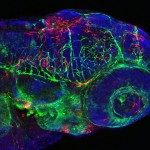Link to Pubmed [PMID] – 10433904
Development 1999 Sep;126(17):3735-45
In the zebrafish embryo, the only known site of hemopoieisis is an intra-embryonic blood island at the junction between trunk and tail that gives rise to erythroid cells. Using video-enhanced differential interference contrast microscopy, as well as in-situ hybridization for the expression of two new hemopoietic marker genes, draculin and leucocyte-specific plastin, we show that macrophages appear in the embryo at least as early as erythroid cells, but originate from ventro-lateral mesoderm situated at the other end of the embryo, just anterior to the cardiac field. These macrophage precursors migrate to the yolksac, and differentiate. From the yolksac, many invade the mesenchyme of the head, while others join the blood circulation. Apart from phagocytosing apoptotic corpses, these macrophages were observed to engulf and destroy large amounts of bacteria injected intravenously; the macrophages also sensed the presence of bacteria injected into body cavities that are isolated from the blood, migrated into these cavities and eradicated the microorganisms. Moreover, we observed that although only a fraction of the macrophage population goes to the site of infection, the entire population acquires an activated behaviour, similar to that of activated macrophages in mammals. Our results support the notion that in vertebrate embryos, macrophages endowed with proliferative capacity arise early from the hemopoietic lineage through a non-classical, rapid differentiation pathway, which bypasses the monocytic series that is well-documented in adult hemopoietic organs.

